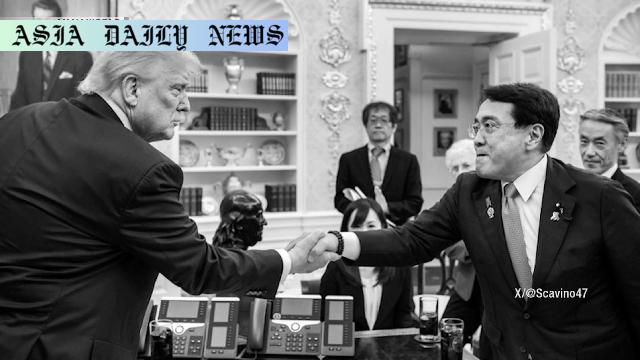Tariff Power guides a historic $550 billion U.S.-Japan agreement, driving Boeing sales, defense spending, and agriculture exports.
- Tariff Power played a key role in securing a $550B U.S.-Japan deal.
- Japan agrees to increase Boeing aircraft purchases and defense spending.
- U.S. agricultural exports to Japan will significantly rise.
- Trump plans to negotiate similar deals with other trading partners, including South Korea and China.

Introduction to the U.S.-Japan Tariff Power Deal
The recent agreement between the U.S. and Japan showcases the effective use of President Trump’s ‘Tariff Power’ strategy, securing a monumental deal valued at $550 billion. Marked by negotiations that touched various sectors including defense, agriculture, and technology, the deal highlights an era of controlled yet aggressive trade policies. While the president’s social media announcement proudly claimed Japan had opened its markets “for the first time ever,” this achievement also sends ripples across negotiations with other trading partners such as South Korea and China, both of which face imminent tariff discussions.
At the core of this deal is Japan’s commitment to invest $550 billion into the United States. The White House confirmed the deal includes the purchase of 100 Boeing aircrafts, which not only benefits the American manufacturing sector but also strengthens long-standing commercial ties between the two countries. Defense spending with U.S. firms is set to grow substantially, reflecting increased collaboration on international security.
Implications for U.S. Agriculture and Defense
In addition to defense and aviation, agriculture plays a significant role in this agreement. Japan will boost its purchase of U.S. rice by 75%, alongside increasing its acquisition of agricultural and other related goods by $8 billion. With domestic farmers often caught in the crossfire of international trade disputes, this level of investment comes as a sigh of relief, contributing to rural economies.
This agreement is also integral to strengthening U.S.-Japan defense ties. Tokyo’s promise to expand defense spending with U.S.-based companies ensures greater military innovation and cooperation within the Asia-Pacific region. The Trump administration views these provisions as strategic moves to not only bolster domestic industries but also maintain stability in key international regions.
The Role of Tariff Power in Global Negotiations
As negotiations loom for other countries, the U.S.-Japan deal sets clear precedents. President Trump’s assertion that only open markets will warrant lower tariffs emphasizes his stance on building reciprocal trading relationships worldwide. South Korea and China, still negotiating terms, are likely to face similar demands, where market accessibility for American products becomes the central talking point.
Political analysts argue that the term ‘Tariff Power’ has become synonymous with Trump’s negotiation tactics. By leveraging high tariff rates as bargaining chips, the U.S. administration has compelled several nations to explore deals heavily tilted towards favoring American interests. Treasury Secretary Scott Bessent’s comment on Bloomberg TV, where he acknowledged Japan’s tough negotiating side, reflects the complexity of these discussions.
Potential Risks and Benefits
While the U.S.-Japan deal brings substantial economic benefits, it also draws attention to potential challenges. Critics argue that the heavy emphasis on leveraging tariffs could strain diplomatic relations, further intensifying global trade tensions. For countries dependent on the United States for exports, the steep price of tariffs could force them to either adhere to U.S.’s terms or risk exclusion from lucrative markets.
However, advocates within the U.S. point to rising investments in key industries and an improved trade balance. For instance, Trump’s example of Japan opening its markets “for the first time ever” serves as a narrative around reclaiming fairness in global trade, particularly in traditionally uncompetitive sectors like agriculture.
Conclusion
The $550 billion U.S.-Japan trade agreement marks a turning point in international trade. By leveraging tariffs as a means of negotiation, President Trump’s administration has ensured significant investments into several growth-driven industries. This momentous deal not only creates economic opportunities but also challenges other nations to reconsider their trading terms with the United States. As discussions with South Korea and China move forward, all eyes remain on how ‘Tariff Power’ reshapes global economic landscapes.



Commentary
Reflecting on the U.S.-Japan Trade Agreement
The recent U.S.-Japan trade deal, hailed as one of the largest agreements under President Trump’s administration, underscores a unique approach to international economic relations. Negotiation through ‘Tariff Power’ feels like a double-edged sword—on one hand, it offers significant leverage, but on the other, it strains bilateral relations. However, the outcome in this case appears overwhelmingly beneficial for the United States, securing investments in aviation, agriculture, and defense.
Impacts on Domestic and Global Economies
The tangible benefits of this agreement, such as Japan’s $550 billion commitment and increased purchases of Boeing aircrafts and American rice, are hard to overlook. For domestic industries, especially agriculture and manufacturing, this deal provides much-needed relief amidst uncertainties from other trade conflicts. However, these benefits come at the expense of heightened global trade tensions, leaving smaller nations to either capitulate or face economic isolation.
Long-Term Implications
From a broader perspective, the U.S.-Japan deal sets the tone for future negotiations. South Korea and China are already in line for discussions, where similar hardball tactics are expected. It’s worth questioning the sustainability of these negotiations; leveraging tariffs might yield short-term gains but could discourage cooperative relationships in the long run. As countries adapt to ‘Tariff Power,’ we might see significant shifts in global trade alignments to counterbalance American dominance.
Final Thoughts
Overall, while the current agreement seems like a win for the U.S., its implications will extend far beyond immediate economic returns. It provides insight into how trade strategies could evolve, forcing nations to adopt stricter policies, balance power, and reassess their priorities. Ultimately, only time will tell whether these moves will fortify or fracture the global economy.